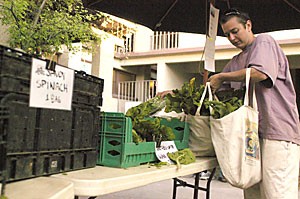From gracing the cover of Time magazine to increasing support for local farmers, the trend of buying locally grown food is taking root across the nation.
In Tucson, venues from stores to community-supported farms are offering local produce to a growing consumer base.
“”Especially this year, the movement for local foods has grown dramatically,”” said Torey Ligon, outreach coordinator for Food Conspiracy Co-op, a market that offers locally grown products. “”All of a sudden we’re hearing people ask questions about what farm is this from, how far away is it.””
The personal connection with the food you are eating is one of the benefits of consuming locally grown food, supporters say.
“”It puts you in touch with who grows your food, where it’s grown, and puts you in touch with the community,”” said Philippe Waterinckx, manager of Tucson Community Supported Agriculture.
Community-supported agriculture is a model for food purchasing in which customers pay a subscription fee to the farmer and receive amounts of produce and other food products for a period of time. CSAs often purchase from smaller farms that offer locally grown food.
Tucson CSA, which was started in February 2004, has grown to include 300 members. Both food producers and customers benefit from the model, Waterinckx said.
“”The nice thing about a CSA for a farmer is you’ve got an established client base,”” said Laurel Loew of Agua Linda farm in Amado. “”If we can get our CSA up to a number that can help sustain us, it makes it a lot easier on us.””
Agua Linda farm participates in a small CSA as well as supplying to Food Conspiracy Co-op and local restaurants.
The environmental impact is another reason many consumers are buying local.
“”One benefit is obviously the positive environmental impact of buying food that was grown 45 minutes from here as opposed to something that was grown in California and then shipped to Wisconsin and then shipped to Tucson,”” Ligon said.
Locally grown food not only cuts down transportation emissions, but also means the product is fresher, as it was picked in some cases only days before sale, said Gale Welter, who manages the UA Farmers’ Market.
Locally grown foods are limited to what can be grown in the area or what is in season.
“”I think a lot of folks still don’t really get it that food is seasonal,”” Loew said. “”Someone will come to the farm in February looking for watermelon. We’ve all been spoiled by grocery stores getting big shipments at any time of the year.””
The UA Farmers’ Market offers products that grow well in desert climates, such as dates, but some produce is not able to be grown in the region.
“”If we do not have strawberries available it’s because, locally, strawberries do not grow in this area, or in this region,”” said Suzanne Dhruv, vendor coordinator for the UA Farmers’ Market.
Smaller farms, which are typically the sources of locally grown food, also face challenges that larger farms do not.
Laurel Loew’s husband, Stewart, for example, was unable to make a delivery one Sunday because he was attending to the difficult birth of a calf, Ligon said. Larger farms can have someone fill in, but smaller farms don’t have the same resources.
Despite the difficulties of locally grown food, people still support the movement.
“”We sell local produce because we really believe in it, not because it’s the easy thing to do,”” Ligon said.









